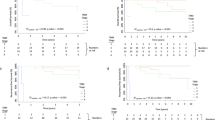Abstract
Background
Goblet cell carcinoids (GCCs) of the appendix are rare mucinous neoplasms, for which optimal therapy is poorly described. We examined prognostic clinical and treatment factors in a population-based cohort.
Methods
Patients diagnosed with GCC from 1984 to 2014 were identified from the British Columbia Cancer Agency and the Vancouver Lower Mainland Pathology Archive.
Results
Of 88 cases with confirmed appendiceal GCCs, clinical data were available in 86 cases (annual population incidence: 0.66/1,000,000). Median age was 54 years (range 25–91) and 42 patients (49%) were male. Metastasis at presentation was the strongest predictor of overall survival (OS), with median OS not reached for stage I–III patients, and measuring 16.2 months [95% confidence interval (CI) 9.1–29] for stage IV patients. In 67 stage I–III patients, 51 (76%) underwent completion hemicolectomy and 9 (17%) received adjuvant 5-fluorouracil-based chemotherapy. No appendicitis at initial presentation and Tang B histology were the only prognostic factors, with inferior 5-year recurrence-free survival (53 vs. 83% with appendicitis, p = 0.02; 45% Tang B vs. 89% Tang A, p < 0.01). Of 19 stage IV patients, 10 (62.5%) received 5-fluorouracil-based chemotherapy and 11 (61%) underwent multiorgan resection (MOR) ± hyperthermic intraperitoneal chemotherapy (HIPEC). Low mitotic rate and MOR ± HIPEC were associated with improved 2-year OS, but only MOR ± HIPEC remained significant on multivariate analysis (hazard ratio 5.4, 95% CI 1.4–20.9; p = 0.015).
Conclusions
In this population-based cohort, we demonstrate excellent survival outcomes in stage I–III appendiceal GCCs and clinical appendicitis. Hemicolectomy remains the standard treatment. In metastatic disease, outcomes remain poor, although MOR ± HIPEC may improve survival.

Similar content being viewed by others
References
van Eeden S, Offerhaus GJ, Hart AA, et al. Goblet cell carcinoid of the appendix: a specific type of carcinoma. Histopathology. 2007;51(6):763–773.
McGory ML, Maggard MA, Kang H, O’Connell JB, Ko CY. Malignancies of the appendix: beyond case series reports. Dis Colon Rectum. 2005;48(12):2264–2271.
Landry CS, Woodall C, Scoggins CR, McMasters KM, Martin RC 2nd. Analysis of 900 appendiceal carcinoid tumors for a proposed predictive staging system. Arch Surg. 2008;143(7):664–70.
Tang LH, Shia J, Soslow RA, et al. Pathologic classification and clinical behavior of the spectrum of goblet cell carcinoid tumors of the appendix. Am J Surg Pathol. 2008;32(10):1429–1443.
Liu E, Telem DA, Warner RR, Dikman A, Divino CM. The role of ki-67 in predicting biological behavior of goblet cell carcinoid tumor in appendix. Am J Surg. 2011;202(4):400–403.
McCusker ME, Cote TR, Clegg LX, Sobin LH. Primary malignant neoplasms of the appendix: A population-based study from the surveillance, epidemiology and end-results program, 1973–1998. Cancer. 2002;94(12):3307–3312.
Pape UF, Perren A, Niederle B, et al. ENETS consensus guidelines for the management of patients with neuroendocrine neoplasms from the jejuno-ileum and the appendix including goblet cell carcinomas. Neuroendocrinology. 2012;95(2):135–156.
Plockinger U, Couvelard A, Falconi M, et al. Consensus guidelines for the management of patients with digestive neuroendocrine tumours: well-differentiated tumour/carcinoma of the appendix and goblet cell carcinoma. Neuroendocrinology. 2008;87(1):20–30.
Boudreaux JP, Klimstra DS, Hassan MM, et al. The NANETS consensus guideline for the diagnosis and management of neuroendocrine tumors: well-differentiated neuroendocrine tumors of the jejunum, ileum, appendix, and cecum. Pancreas. 2010;39(6):753–766.
Pham TH, Wolff B, Abraham SC, Drelichman E. Surgical and chemotherapy treatment outcomes of goblet cell carcinoid: a tertiary cancer center experience. Ann Surg Oncol. 2006;13(3):370–376.
Bucher P, Gervaz P, Ris F, Oulhaci W, Egger JF, Morel P. Surgical treatment of appendiceal adenocarcinoid (goblet cell carcinoid). World J Surg. 2005;29(11):1436–1439.
Lamarca A, Nonaka D, Lopez Escola C, et al. Appendiceal goblet cell carcinoids: Management considerations from a reference peritoneal tumour service centre and ENETS centre of excellence. Neuroendocrinology. 2016;103(5):500–517.
Turaga KK, Pappas SG, Gamblin T. Importance of histologic subtype in the staging of appendiceal tumors. Ann Surg Oncol. 2012;19(5):1379–1385.
Kulke MH, Siu LL, Tepper JE, et al. Future directions in the treatment of neuroendocrine tumors: Consensus report of the national cancer institute neuroendocrine tumor clinical trials planning meeting. J Clin Oncol. 2011;29(7):934–943.
Hallet J, Law CH, Cukier M, Saskin R, Liu N, Singh S. Exploring the rising incidence of neuroendocrine tumors: A population-based analysis of epidemiology, metastatic presentation, and outcomes. Cancer. 2015;121(4):589–597.
Mahteme H, Sugarbaker PH. Treatment of peritoneal carcinomatosis from adenocarcinoid of appendiceal origin. Br J Surg. 2004;91(9):1168–1173.
Cashin P, Nygren P, Hellman P, Granberg D, Andreasson H, Mahteme H. Appendiceal adenocarcinoids with peritoneal carcinomatosis treated with cytoreductive surgery and intraperitoneal chemotherapy: a retrospective study of in vitro drug sensitivity and survival. Clin Colorectal Cancer. 2011;10(2):108–112.
Funding
This research did not receive any specific grant from funding agencies in the public, commercial, or not-for-profit sectors.
Author information
Authors and Affiliations
Corresponding author
Ethics declarations
Disclosures
Erica S. Tsang, Yarrow J. McConnell, David F. Schaeffer, Lawrence Lee, Yaling Yin, Siham Zerhouni, Kimberly Schaff, Caroline Speers, and Hagen F. Kennecke declare that no conflicts of interest exist.
Electronic supplementary material
Below is the link to the electronic supplementary material.
Rights and permissions
About this article
Cite this article
Tsang, E.S., McConnell, Y.J., Schaeffer, D.F. et al. Outcomes of Surgical and Chemotherapeutic Treatments of Goblet Cell Carcinoid Tumors of the Appendix. Ann Surg Oncol 25, 2391–2399 (2018). https://doi.org/10.1245/s10434-018-6560-0
Received:
Published:
Issue Date:
DOI: https://doi.org/10.1245/s10434-018-6560-0




